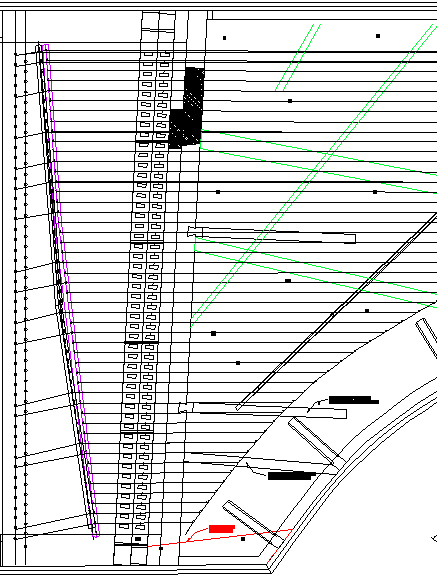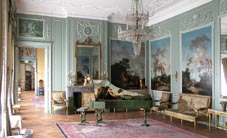D R A W I N G S
available from Grant O'Brien
Anonymous Neapolitan single-manual harpsichord, c.1630
Property of the Markiezenhof Centrum, Bergen-op-Zoom, The Netherlands
Drawing made by Johnny Bell.


The instrument with its outer case and stand (drawings not included) (right) and a detail of the drawing (right).
This harpsichord was drawn by Johnny Bell using AutoCAD drawing and is clear and easy o use. It is of a single-manual Neapolitan harpsichord which originally had a compass of C/E to c3 but with a split D/F# and E/G#. This compass was then later altered to C,D to c3 adding one note in the treble and moving the nut slightly to change the scalings which otherwise would inevitably have been altered in the compass change. Both states had a disposition of 2x8' and both the original state and the present state are suitable for brass stringing at normal pitch (A415). The original, intermediate, non-historical and the modern restored state are distinguished in different colours. The drawing includes the main instrument with sections drawn through various points of the case, the keyboard, etc. with bridge and nut sections, soundboard thicknesses, etc. There is everything here you need to make a copy of the instrument in either the original or the intermediate/restored state! It is also interesting as an example of the alterations the instrument has undergone which illustrate changing musical taste and restoration philosophy.
Drawing 10 shows the stand made for this instrument from a drawing which is also available here.
This instrument now belongs to the Markiezenhof Museum in Bergen-op-Zoom in The Netherlands. The drawing is available only from this site - the Markiezenhof does not hold copies of the drawing for sale.
Drawing Dimensions: 3000mm long by 850mm wide
The Instrument
This instrument has been shown by Grant O’Brien to be of Neapolitan construction and the details are outlined on this site. Further details of the instrument can be found on this site.
The instrument has gone through a number of states in the course of its history. It originally had a compass of C/E to c3 with a split D/F# and E/G#. This was then later altered, almost certainly in the historical period, to C,D to c3 by adding one note in the treble and moving the nut to shorten the scalings which were lengthened as a result of the compass change. The new nut position again gave scalings with a value suitable for brass stringing. Both of these states had a disposition of 2x8' and were suitable for brass stringing at normal pitch (A415).
There is an inscription, clearly having nothing to do with the original maker, on the lower part of the cheek near the cheek/bentside join which reads: "Io Giusseppo di Lucia organaro Caserta / Strada dei orefi numero 91 / 1824 / casa cominco coro Caserta" or, in modern Italian the last part only would read: “Cassa comincio col’oro [=con l’oro] Caserta)”. The translation of this inscription is therefore: “I, Giusseppo di Lucia, organ builder in Caserta in the Strada dei Orefi[ci] (The Goldsmith’s Street) number 91, began to gild the case in 1824 in Caserta”. This has been inscribed in cursive script with a sharp pointed (metal?) object but is now very difficult to read and transcribe. There is also a label hidden inside the instrument that reads: “Repariert v[on] Hermann / Se˙ffarth Leipzig-Gohlis / 1904” (Repaired by Hermann Se˙ffarth in Leipzig-Gohlis 1904). This label clearly refers to a repair made to the instrument and, because it is inside a part of the instrument normally sealed and out of sight, pinpoints the time at which the instrument was opened and the internal alterations and additions were carried out. It seems likely that the keylevers, natural touchplates (both seem to be from a Viennese fortepiano), and the nut, keyboard cloths, quills, and the additional bracing and soundboard barring which were found on the instrument when bought all date from one or both of these two modern periods. Elements which date from these two alterations are labelled as the 1824-Seyffarth state in the drawing and are drawn in green.
There may well have been other historical or recent states which cannot now be distinguished. The instrument was restored to the intermediate (second) historical state with the compass C,D to c3. In the drawing elements of the original state of the instrument are drawn using black lines and the intermediate and restored states are drawn using magenta and red lines.
(Click on the image below to see a larger-sized version of it.)
The anonymous Neapolitan harpsichord in the Period Room, Markiezenhof Musem, Bergen op Zoom, The Netherlands.
Return to the main catalogue of drawings
Go to the Markiezenhof website

